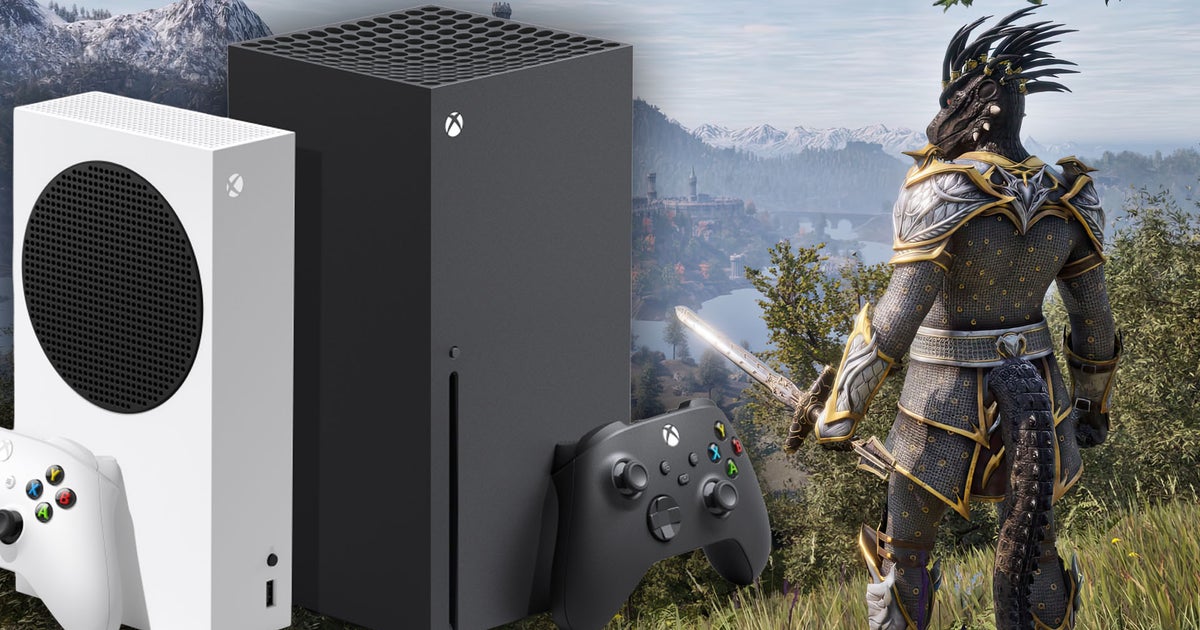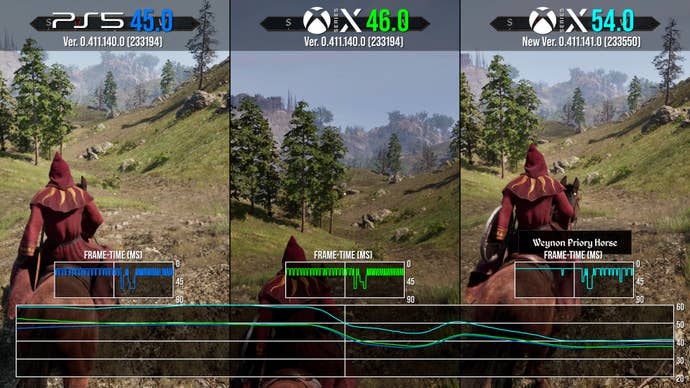Oblivion Remastered: a crucial patch improves Series X performance – but it’s still not good enough

Oblivion Remastered’s shadow drop surprised no-one given that it was among the worst kept secrets over the last few weeks, but what did surprise was the sheer extent of its visual overhaul. Described by creative director Todd Howard as keeping the bones – the core logic – of the original 2006 game intact, it’s fallen on developer Virtuos to use Unreal Engine 5 to re-work the visual layer. It’s a much needed move, and the remaster gives us the works, deploying the full suite of UE5 features as a graphics renderer. Cyrodiil’s lighting is transformed via its Lumen technology, allowing for an approximated form of ray traced global illumination and reflections, with dynamic shadows. Character models, materials, and effects are also reworked from scratch – plus we get a new locomotion system helping to address the rather stilted animations of the original. Best of all, Virtuos adds quality of life improvements like a modernised UI, levelling system, a sprint button, and even an updated lip-sync technology for NPCs.
We’ve already looked at the PC game but today’s console coverage is limited to the Xbox Series X and S versions of the game, with PS5 and Pro to follow. There’s a simple reason for this. Last Friday saw a new patch deployed for the Xbox versions of the game that make significant improvements to the game’s somewhat dodgy performance issues – but as of this writing, a matching PlayStation patch has yet to appear. Therefore, the focus shifts to Xbox Series X performance and quality modes and the singular Series S 30fps mode.
Kicking off with Series X, the game translates beautifully to Microsoft’s flagship machine with a software based form of UE5’s Lumen. Model quality and materials are standout, and the good news is that both of Series X’s graphics modes deliver the goods. The biggest change is in Lumen GI quality, where quality mode runs at a higher setting – resolving lighting and shadow bounces more accurately. This most notably affects the detailing of shade in interiors, and the bounce lighting on the undersides of arches. In the open world, shadow filtering is also much improved on quality mode, sharpening shadow detail at range, while tree LOD levels, and grass draw distances are pushed up a preset too. Most of the quality mode benefits are in long distance detail though, where up-close detail like textures, shadows and geometry are identical either way. Finally, native resolution is the other main dividing point. In order to hit 60 frames per second, the performance mode targets 1440p in the very best case – which it reaches on the inventory screen where it only has to render a character model. In practise though, Series X runs at a 1760×990 in most typical outdoor gameplay at 60fps. The 30fps quality mode meanwhile pushes to a higher 1620p peak value – again in the inventory screen – while most actual gameplay rests at a native 1440p in typical play, and a worst case figure coming in at 1296p.
In effect, the cost of running at 60fps boils down to an image quality hit, lower world LODs, and a drop in lumen GI quality. Clarity is reduced in still shots then, but we’re getting more pixel data per second this way – thanks to the doubling in frames rendered by the console. It’s my recommended pick despite the cutbacks, though there are some major performance issues to point out here. Testing frame-rate performance on Series X, the 60fps target is well met in most small areas – like dungeons, or inside the city walls. Here, the only grievance is really the presence of odd hitching: some coincide with auto-saves, while others are related to striking an enemy, switching camera view, or simply starting a conversation with an NPC. There’s no escaping it: frame-time spikes are possible even in simpler spots, but generally dungeons hold well at the 60fps mark so far.
However, easily the biggest issues at 60fps arise when you set foot in the open world. Especially while galloping at pace on horseback, traversal stutters are a constant problem on Series X in certain regions. Winding your way down a mountain-top for example, you’ll see frequent spikes to 70ms, and at worst a cluster of dropped frames taking us to 140ms. Often these hitches coincide with pop-in – for geometry on major buildings far ahead – and at set points outside the city walls, it’s also accompanied by a frame-rate in the 40-50fps range. Most of the drops appear to stem from a CPU limit – in handling the original game logic, and world streaming. Thankfully not all areas are quite at this extreme, but it’s still easy to stumble on regions which do run constantly at sub-60fps. This matches Alex’s findings on PC as well, where a powerful CPU is a must for attaining high frame-rates. In the end, rapid movement equates to a higher frequency of hitches while outdoors, and sustained drops, while moving more slowly on foot reduces the likelihood of issues.
This is all running on the very latest patch on Series X – the April 25th update which shows version number 233550 in the game settings menu. Astonishingly, this is an improvement over what we had in the launch build. Compared to my banked footage of the older version 233194, we’re now running at frame-rates up to 16fps higher on Series X. Weather and cloud coverage is hard to control precisely between runs, but the overall trend is clear. Virtuos’ new patch improves all stress test areas on Series X and while clearly imperfect in its current state, it makes this mode more viable for VRR displays – with Series X offering a workable range of 40-60Hz. Whether it’s galloping across the landscape, or battling through the volcanic Planes of Oblivion, the new patch is more adept at keeping it above 40fps. That said, the hitches and stutters remain, and always in the exact same spots while traversing the world. One final point on this: I looked into a potential visual downgrade between patches, and results were largely inconclusive. A few shots suggest a drop in GI setting for this performance mode, but repeat tests ended up showing matching lighting in booting the same save. Otherwise, settings – and even native resolutions – are identical between versions, so we’re likely looking at optimisations under the hood, in its handling of the original Oblivion logic.
We’re reserving judgement on PlayStation 5 and Pro until it receives its matching patch but as things stand, the frame-rate reading for the base console tracks closely with Series X on its equivalent, older build. Everything mentioned about Series X applies here. PS5 in its 60fps mode runs well in dungeons, barring the odd hitch. It also shares the same native resolution target, peaking at 1440p in the 60fps mode – while curiously, most typical gameplay comes in at a lower 900p. Sadly, it also shares a problem in handling any open world roaming at pace, where traversal hitches are glaring. In using a matching mountain top run as a stress test, base PS5 often runs at a similar average 35-50fps range to Series X on the older patch: sometimes higher, sometimes much lower depending on the point of the run. It’s not clear why there are variances here between consoles, but it’s clear PS5 is in need of attention to bring it closer to Series X’s latest build.
Moving on to the quality mode on Series X, there’s a 30fps cap in place while running at a higher average resolution, improved GI and LODs. Despite the benefits, it’s hard to recommend overall for two reasons: firstly because it’s an unevenly frame-paced 30fps, with constant trills to 16, 33 and 50ms registered on the frame-time graph. Even in simple dungeon areas there’s a constant judder to screen motion as a result, which is a distraction. Secondly, while traversal is essentially evened out at the 30fps line, some major hitches remain on Series X. The visibility threshold for hitches is higher, given the 33.3ms frame time, but any spikes which occur above that continue to stick out like a sore thumb. Overall, it must be said that the reading is otherwise flat at 30fps – barring the hitches – and if Virtuos could fix the uneven frame pacing it’d be much more usable.
All of which brings us to Xbox Series S situation. The reality for anyone playing on Series S is that they will have to make do with a similar 30fps experience to the Series X quality mode. There is no 60fps performance option, and so it’s only possible to play with uneven frame-pacing at 30 in this case. Generally speaking Series S runs with a constant 30fps reading and no GPU-limiting drops under that number even in effects-heavy battles around the Oblivion planes. The main cause for drops under the 30fps line though, much like on the premium Xbox machine, is in traversal stutters which kick in at the exact same points in the world.

To compound the issue, Series S also makes visual cutbacks to sustain its 30fps line. First of all the resolution is dropped to a 900p target, with a lower bounds reading coming in at around 810p. Next to Series X’s own 30fps quality mode there is a drop-off in image quality, but overall it’s still a decent turnout. More striking is the drops in settings elsewhere. We have significantly pruned back grass draw, tree LODs, lower grade shadow quality, and even environmental textures are dropped a setting. You’ll even notice plant density is lowered, meaning the earth at your feet appears more barren and stripped of foliage.
Finally, there is a difference to the quality of the game’s global illumination, where Series X manages to more thoroughly light and shade interior areas. Much of this is even lower than Series X’s performance mode. All round, Series S sadly takes a hit in most aspects, and the result certainly removes some of the lustre of the remaster. The hit to texture quality in particular is a sore point but par for the course with Series S.
There’s plenty to be positive about with developer Virtuos’ work on Oblivion Remastered, to the point where calling it a remaster seems to be selling it short. It’s a true current-gen release that showcases Unreal Engine 5’s latest tech but for all its eye candy, profound issues need to be addressed. Xbox Series S owners are lumbered with a single unevenly frame paced 30fps mode, with some disappointing cutbacks in texture and world detail. Meanwhile, even on the latest patch, Series X users must decide between two compromised options: a 30fps mode with similar frame pacing issues, or a 60fps option with drops in the open world. Traversal hitches are a serious problem and represent a foundational issue from the original game that should have been fixed as a priority for the new game. Even so, all of these performance issues should ideally not distract from what is otherwise a remarkable remaster project – but they are too egregious to ignore.



